You are using an out of date browser. It may not display this or other websites correctly.
You should upgrade or use an alternative browser.
You should upgrade or use an alternative browser.
Heat Treatment Oven
- Thread starter Dr.Al
- Start date
Dr.Al
Forum Supporter
- Messages
- 2,623
- Location
- Gloucestershire, UK
I would expect to see the TC junction at least -50mm from any surface in that sort of oven.
Thanks, that's good to know. I'll make that my target. It isn't something I'd seen mentioned in any of the stuff I read / watched beforehand so I just tucked them out of the way. Live & learn...
For decent temperature uniformity, you would probably need some sort of air circulation.
Yeah, that makes sense. I don't think it's going to happen in this oven though. I'd hoped that the cavity was small enough that it wouldn't vary **that** much over the volume.
No, no vents.Does this have a top vent with a restrictor in it ?
timgunn1962
Member
- Messages
- 362
- Location
- Lancashire UK
I've always been told that, as a general rule of thumb, temperature sensors should be inserted into the process by 10 diameters.
Dr.Al
Forum Supporter
- Messages
- 2,623
- Location
- Gloucestershire, UK
The advice above suggested that the thermocouples should stick out at least 50 mm or ten times the diameter of the tip. The tip diameter is 5 mm, so that tallies nicely! I replaced all three thermocouples; they all now protrude about 55 mm into the chamber:
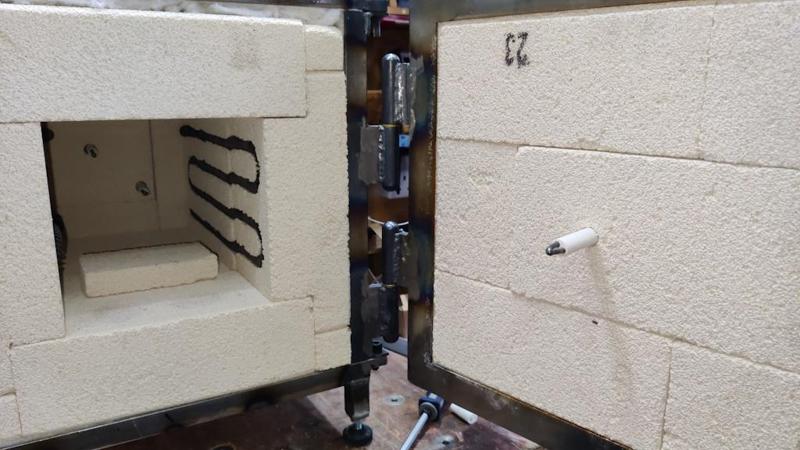
I haven't trimmed the excess yet, but they'll all have to come back out soon as I need to paint the chamber.
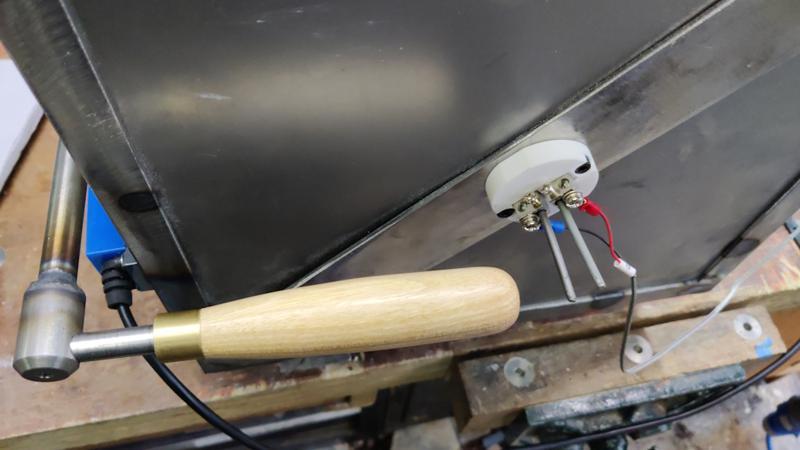
The eagle-eyed among you will have notice that I've now wired up the door interlock, which should make the whole thing a lot safer.
With that done, the temperature seems much more consistent over the cavity (i.e. the thermocouples at the rear agree with the ones at the front). I also used a separate low-temperature thermocouple for some tests at around 200°C and that thermocouple agreed as well, so I think the extension of the thermocouples was well worth it. Tempering the little test blade produced a much better colour this time, although it was hard to photograph and I don't think the image shows the colour that well:
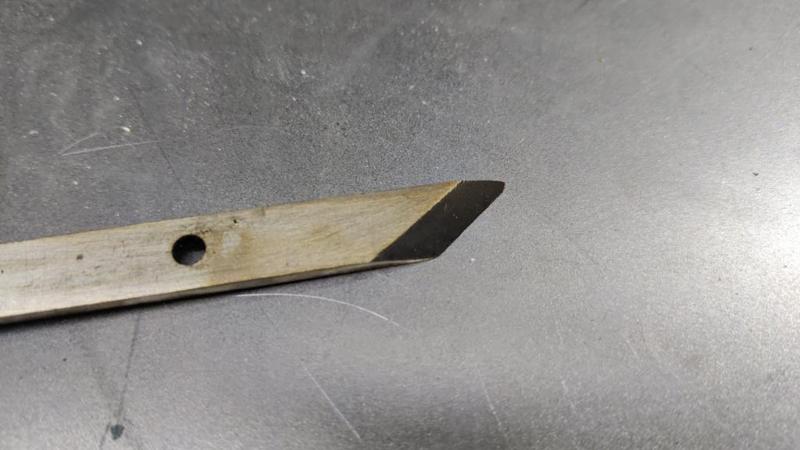
With the blade tempered, I could give it a bit of TLC in the form of some rubbing on wet-and-dry, some sharpening and the addition (with epoxy) of some wenge scales. With that done and a coat of Mike's Magic Mix applied, the marking knife is finished:
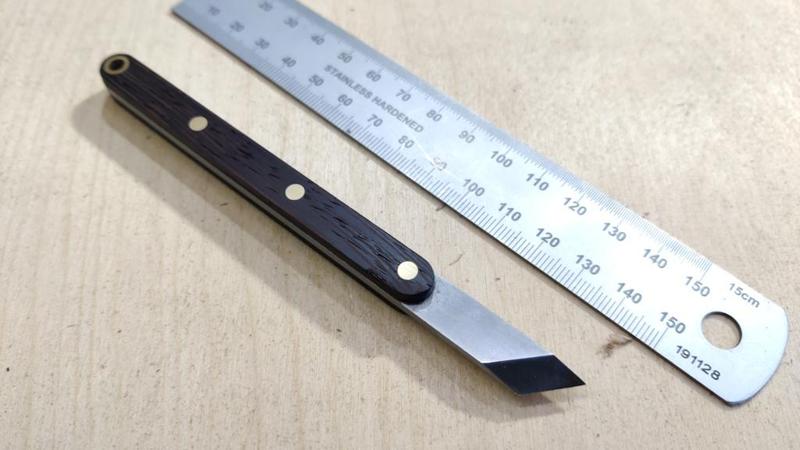
Side view:
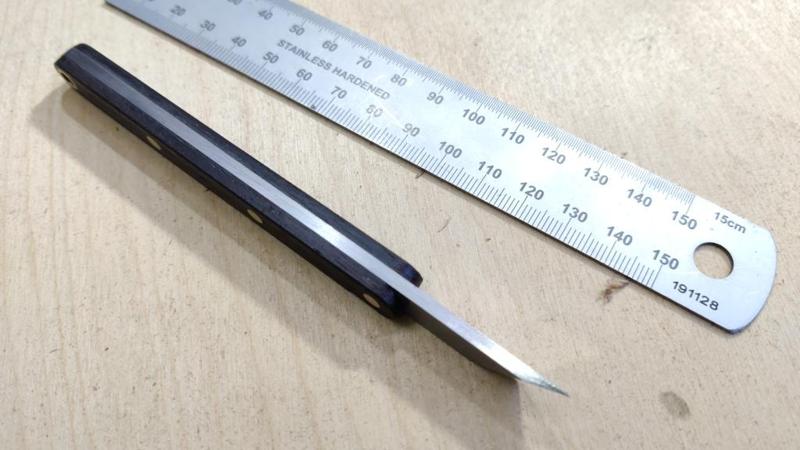
This knife is well within the realms of things that could be done with just a blowtorch rather than requiring a big and complicated heat treatment oven, but I wanted to do something to test the chamber and this was a nice quick and simple project to use for the trial.

I haven't trimmed the excess yet, but they'll all have to come back out soon as I need to paint the chamber.

The eagle-eyed among you will have notice that I've now wired up the door interlock, which should make the whole thing a lot safer.
With that done, the temperature seems much more consistent over the cavity (i.e. the thermocouples at the rear agree with the ones at the front). I also used a separate low-temperature thermocouple for some tests at around 200°C and that thermocouple agreed as well, so I think the extension of the thermocouples was well worth it. Tempering the little test blade produced a much better colour this time, although it was hard to photograph and I don't think the image shows the colour that well:

With the blade tempered, I could give it a bit of TLC in the form of some rubbing on wet-and-dry, some sharpening and the addition (with epoxy) of some wenge scales. With that done and a coat of Mike's Magic Mix applied, the marking knife is finished:

Side view:

This knife is well within the realms of things that could be done with just a blowtorch rather than requiring a big and complicated heat treatment oven, but I wanted to do something to test the chamber and this was a nice quick and simple project to use for the trial.
hotponyshoes
Member
- Messages
- 7,786
- Location
- Somerset. Uk
You'll need more than 2 lumps of charcoal to prevent scale. The amount is relative to the size of the chamber, not the size of the part. The idea is, the charcoal burns and consumes all the oxygen in the chamber.
Doesn't have to be charcoal, anything that burns works. But charcoal is good for the lack of smoke/fumes.
I'd say you would want to get a tray full size of the base and fill that with charcoal. Smash into smaller pieces helps as well.
Couple of riser rods under the tray to get heat under it.
That will also have the advantage of protecting the floor bricks as that's the area that will wear out first.
Its still not particularly effective as the scale will still form on the part until all the oxygen has been consumed (which takes a while)
Inert gas purge is pretty good, not necessarily expensive (if you already have argon you can use that) initial purge at a good rate then just a trickle will do the job.
Or look up heat treating foil. Basically just stainless steel tin foil that you wrap around tightly. Only really works on parts that are the right shape for wrapping though
Another cheap option is a vacuum pump. I've not studied the whole thread to see what the chamber construction is like but I did see you mention you had some gaps in the block work, if you are not seeing silly temps on the outside then adhesive aluminium tape will probably seal it up well enough for vacuum to make a decent difference.
Doesn't have to be charcoal, anything that burns works. But charcoal is good for the lack of smoke/fumes.
I'd say you would want to get a tray full size of the base and fill that with charcoal. Smash into smaller pieces helps as well.
Couple of riser rods under the tray to get heat under it.
That will also have the advantage of protecting the floor bricks as that's the area that will wear out first.
Its still not particularly effective as the scale will still form on the part until all the oxygen has been consumed (which takes a while)
Inert gas purge is pretty good, not necessarily expensive (if you already have argon you can use that) initial purge at a good rate then just a trickle will do the job.
Or look up heat treating foil. Basically just stainless steel tin foil that you wrap around tightly. Only really works on parts that are the right shape for wrapping though

Another cheap option is a vacuum pump. I've not studied the whole thread to see what the chamber construction is like but I did see you mention you had some gaps in the block work, if you are not seeing silly temps on the outside then adhesive aluminium tape will probably seal it up well enough for vacuum to make a decent difference.
Kram
Member
- Messages
- 8,188
- Location
- Sussex
To avoid scale, how about a flux such as borax, paint the part with it then a citric acid dip after to remove.
Clickspring in some videos, where he heats parts in a fire, uses some kind of clay to protect items. Its interesting as any time I have used clay, it has cracked, so something specific is needed.
Another option is spray the part with graphite spray, or just cover in graphite/charcoal powder
Another is paint it with sodium sillicate or a paste perhaps with charcoal dust. I use SS for protecting the outside of cruicibles. Im not sure if its easily removed as I havent tried on metal.
One more idea is light a small candle/tea light and let it burn most if the oxygen before you raise the temperature too high.
Clickspring in some videos, where he heats parts in a fire, uses some kind of clay to protect items. Its interesting as any time I have used clay, it has cracked, so something specific is needed.
Another option is spray the part with graphite spray, or just cover in graphite/charcoal powder
Another is paint it with sodium sillicate or a paste perhaps with charcoal dust. I use SS for protecting the outside of cruicibles. Im not sure if its easily removed as I havent tried on metal.
One more idea is light a small candle/tea light and let it burn most if the oxygen before you raise the temperature too high.
Dr.Al
Forum Supporter
- Messages
- 2,623
- Location
- Gloucestershire, UK
I've used boric acid (borax) mixed with meths before & it works well (just needs a soak in boiling water to remove it). That's the same thing that Clickspring uses. He typically wraps the part in wire to keep the boric acid mix in. I've done that in the past, but I think I might weld up a little tray. Otherwise the boric acid mix will just leak all over the bottom of the oven.
I think the clay thing that Clickspring has done is when he's been case-hardening: covering the parts in something rich in carbon
I think the clay thing that Clickspring has done is when he's been case-hardening: covering the parts in something rich in carbon
hotponyshoes
Member
- Messages
- 7,786
- Location
- Somerset. Uk
I'd tried various different ways of preventing scale.
Nothing was really quick or easy or perfect.
I then did some experiments and worked out it was costing about £3 an hour to purge with argon. Very little effort, no mess, no post treatment clean up.
I reckon it cost me £30 or so initially (I already had argon and a purge monitor for the tigs). I've probably spent another £100 upgrading but some of that cost was me buying bits I could have made.
I reckon it's running under £2/hr now.
If I had a fancy controller like the op's I'd be reading the manual to see if I could make the purge automatic and see if I could hit £1.50/hr or under..
Nothing was really quick or easy or perfect.
I then did some experiments and worked out it was costing about £3 an hour to purge with argon. Very little effort, no mess, no post treatment clean up.
I reckon it cost me £30 or so initially (I already had argon and a purge monitor for the tigs). I've probably spent another £100 upgrading but some of that cost was me buying bits I could have made.
I reckon it's running under £2/hr now.
If I had a fancy controller like the op's I'd be reading the manual to see if I could make the purge automatic and see if I could hit £1.50/hr or under..
Dr.Al
Forum Supporter
- Messages
- 2,623
- Location
- Gloucestershire, UK
I thought it would be a good time to document the user interface to the control cabinet as it stands at the moment:
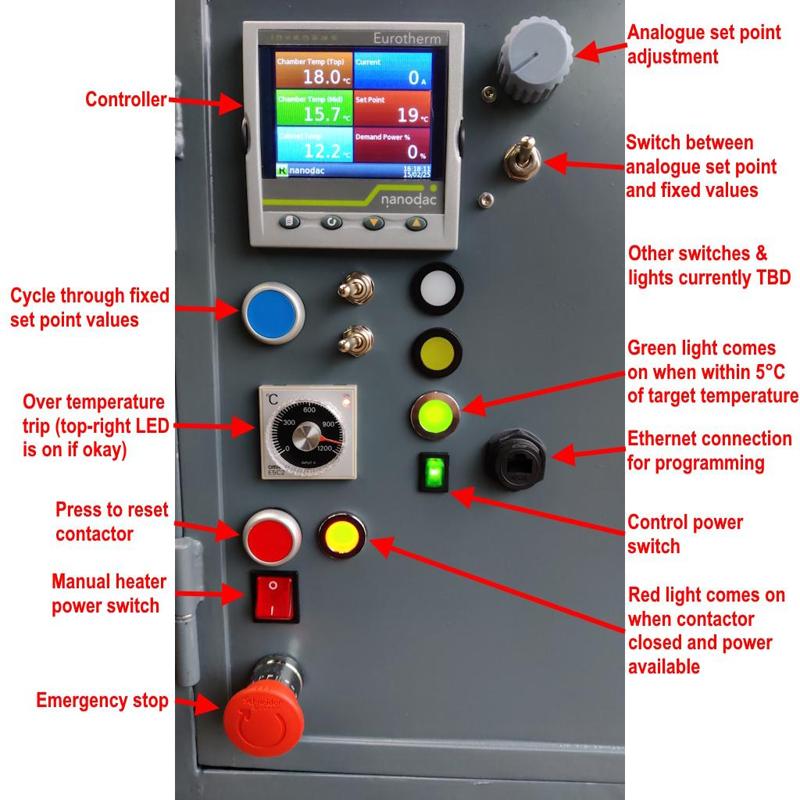
There are two un-allocated switches and two un-allocated lights. The plan for these is to control some more advanced functions using the controllers "programmer", but I haven't quite got there yet.
Similarly, I've documented what the connections on the side do:
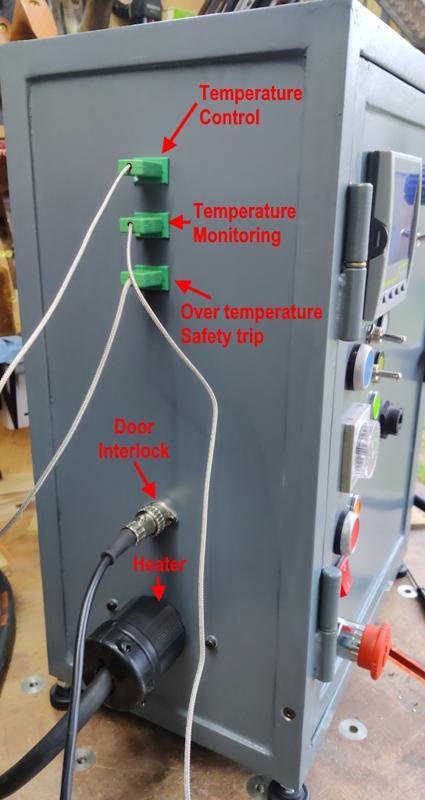
For both the side connections and the various buttons / lights, I may add some labels at some point to make the function clearer, but I'll leave that until I'm fairly certain they won't change again.
This is a short video giving an idea of the user interface to the control cabinet:
First, I adjust the over temperature trip setting and you'll see the light go out (and perhaps hear the contactor releasing) when the dial is turned right down. Then, after turning the dial back up, I reset the contactor. The blue button is then used to cycle through some pre-defined set points, which you'll see displayed on the middle-right box on the controller display. The top-right switch is then used to change to analogue set point control, using the potentiometer, before switching back to the previous fixed set point. I then go back to analogue set point control and show that, if the set point is within 5°C of the chamber temperature, the green light comes on. The heater power switch is then used to connect the power to the chamber (you can possibly hear a quiet buzzing noise in the background) and the current read-out (top right of the controller display) changes. Finally (out of shot), I open the cabinet door and the door interlock trips the contactor. Hopefully that's all clear.
Meanwhile, I've also painted the chamber, using a couple of coats of this stuff, which is rated to 650°C (hopefully the outer skin of the chamber won't get that hot):
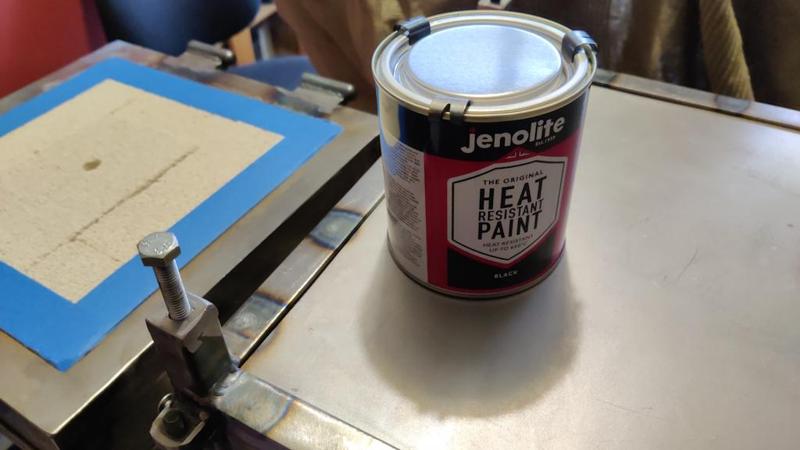
As you can see from this slightly blurry side view (I'll get some better photos if we ever see some sunshine!), I left the stainless steel components (the handle) unpainted and used chemical blacking compound for the latch piece on the end of the handle:
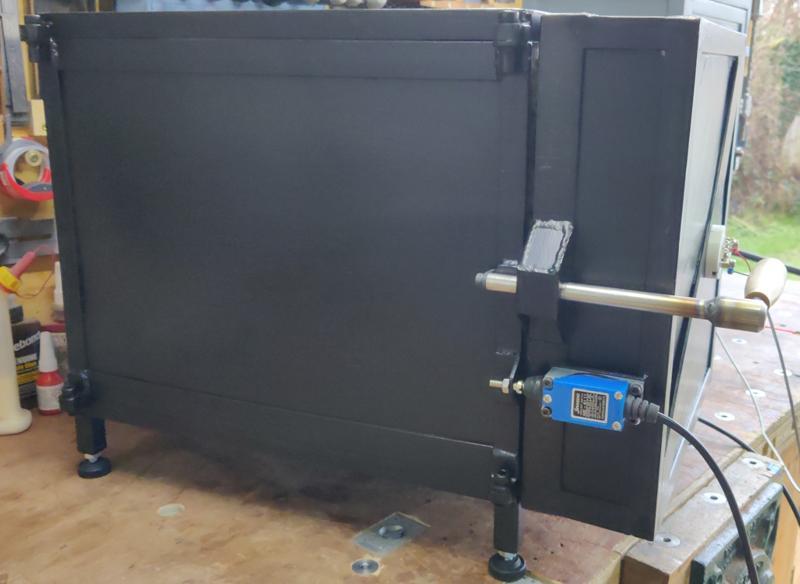
Here's a view of it wired up to the control cabinet:
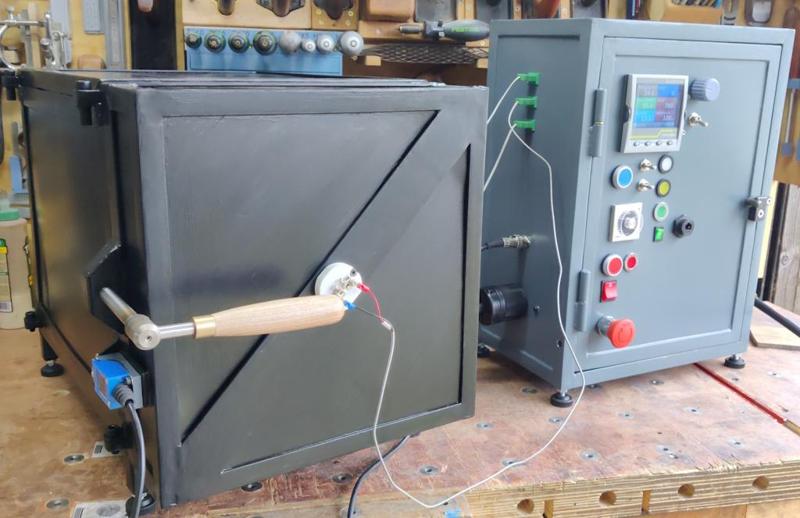
I painted it all without taking it apart, but I think I managed to get to most of the exposed steel without getting too much into threads or onto bricks:
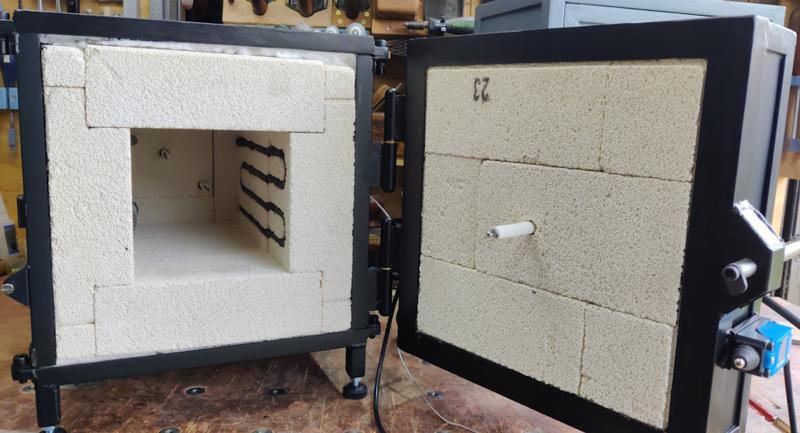
One more photo for luck:
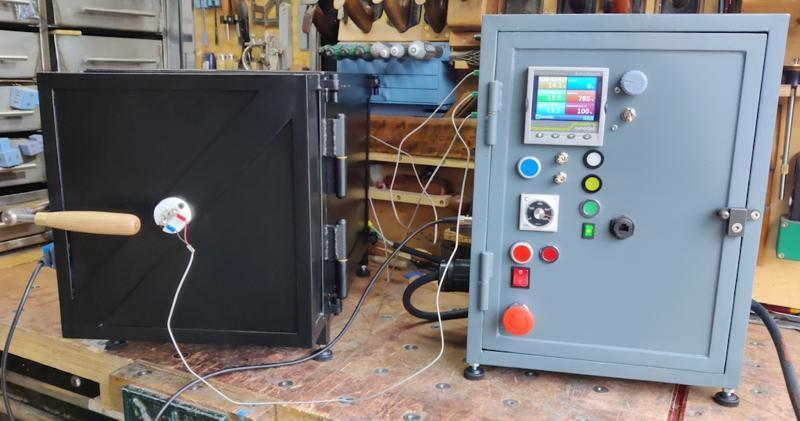

There are two un-allocated switches and two un-allocated lights. The plan for these is to control some more advanced functions using the controllers "programmer", but I haven't quite got there yet.
Similarly, I've documented what the connections on the side do:

For both the side connections and the various buttons / lights, I may add some labels at some point to make the function clearer, but I'll leave that until I'm fairly certain they won't change again.
This is a short video giving an idea of the user interface to the control cabinet:
First, I adjust the over temperature trip setting and you'll see the light go out (and perhaps hear the contactor releasing) when the dial is turned right down. Then, after turning the dial back up, I reset the contactor. The blue button is then used to cycle through some pre-defined set points, which you'll see displayed on the middle-right box on the controller display. The top-right switch is then used to change to analogue set point control, using the potentiometer, before switching back to the previous fixed set point. I then go back to analogue set point control and show that, if the set point is within 5°C of the chamber temperature, the green light comes on. The heater power switch is then used to connect the power to the chamber (you can possibly hear a quiet buzzing noise in the background) and the current read-out (top right of the controller display) changes. Finally (out of shot), I open the cabinet door and the door interlock trips the contactor. Hopefully that's all clear.
Meanwhile, I've also painted the chamber, using a couple of coats of this stuff, which is rated to 650°C (hopefully the outer skin of the chamber won't get that hot):

As you can see from this slightly blurry side view (I'll get some better photos if we ever see some sunshine!), I left the stainless steel components (the handle) unpainted and used chemical blacking compound for the latch piece on the end of the handle:

Here's a view of it wired up to the control cabinet:

I painted it all without taking it apart, but I think I managed to get to most of the exposed steel without getting too much into threads or onto bricks:

One more photo for luck:

Dr.Al
Forum Supporter
- Messages
- 2,623
- Location
- Gloucestershire, UK
Following yesterday's paint job, I thought it would be good to take the chamber back up to temperature just to check that the paint didn't suffer any ill effects. With the thermocouples sticking out into the air rather than only poking slightly out from the bricks, the temperature is much more consistent:
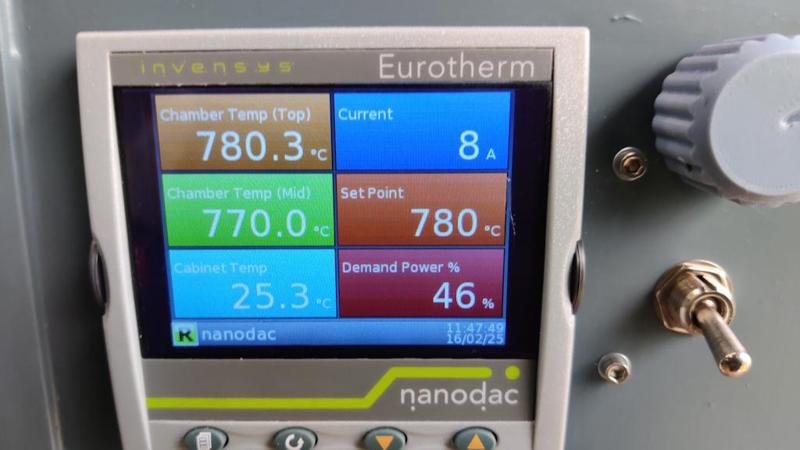
The top-left reading is from the back of the chamber; the mid-left one is from the front (the thermocouple in the door). It took longer for the temperature at the door to stabilise than that at the rear; I suspect that's a combination of the two simple factors: the geometry of the element slot (a bit more heating at the back than the front) and the fact I'd put a large lump of steel (roughly 12 mm × 100 mm × 100 mm) at the front of the chamber and that's quite a lot of thermal mass.
With the thermocouples measuring air temperature (rather than, perhaps, brick temperature), heating was much more rapid; it reached 700°C in about 15 minutes and got to 780°C (at the back of the chamber) in 20 minutes. That took 28 minutes on the previous test. I think it can be made a little bit faster again. The controller was hunting quite a bit: turning the power down before it had got close to the target and then having to put more power in when the temperature started dropping too early. I'm pretty sure that's a result of having run the auto-tune algorithm with the thermocouples semi-buried: the controller "thinks" there's more thermal mass and hence has to turn the power down earlier. Once it's fully cooled, I'll run the auto-tune again and that should help a bit.
While it was warming up, I took a few more photos, this time with the SLR. They're still not great; I think the dingy overcast day doesn't help and, let's be honest, neither does my lack of photographic talent!
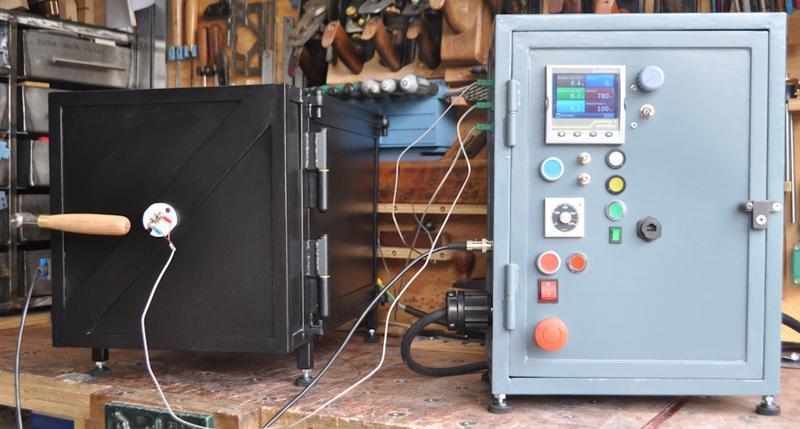
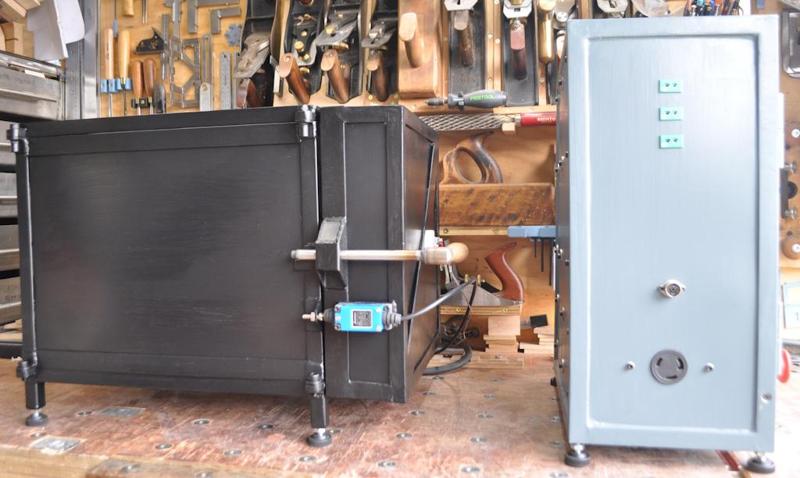
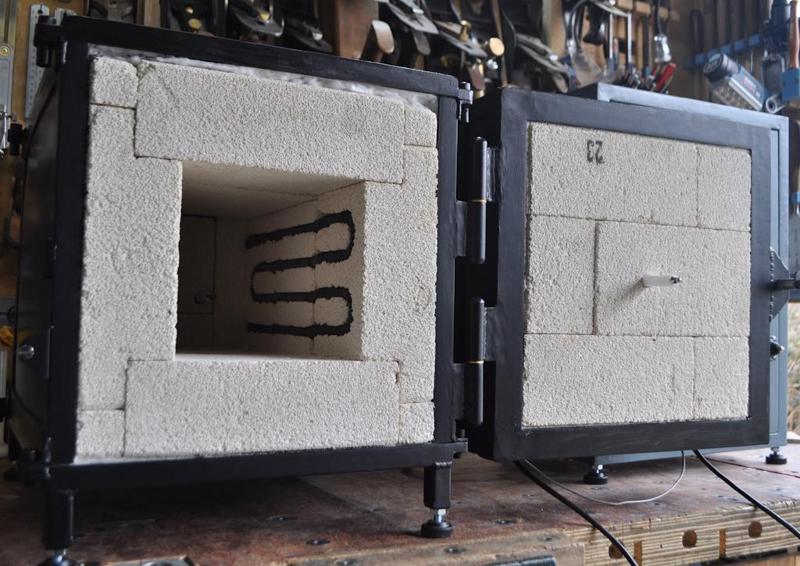
Once it had been up to temperature for quarter of an hour or so, I opened the door and got a photo inside:
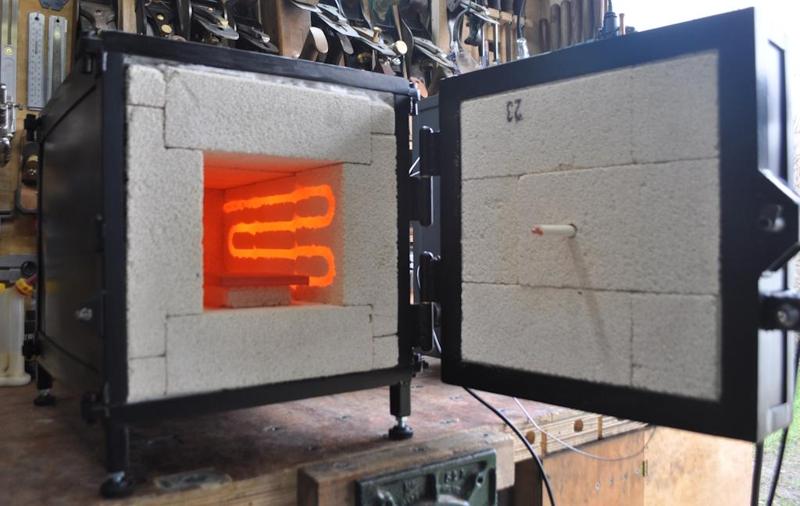
In that photo, you can see the big glowing lump of steel I put in the chamber for this test. It was just a random bit of structural steel I dug out of my odds and ends drawer, so I didn't try to quench it once it was up to temperature or anything like that: I just left it in the oven to cool along with everything else. The only reason I put it in there was that I wanted to prove to myself (not that I ever doubted it really) that I could use the chamber to heat big bits of steel. There is no way I would have been able to heat treat something that size with just a blowtorch but the oven makes it possible. I can't imagine ever needing to harden a piece of 12 mm × 100 mm × 100 mm steel, but I can see me wanting to make reasonable thickness (3–5 mm) plane blades in future and if the blades are wide then there's quite a bit of steel to heat up.

The top-left reading is from the back of the chamber; the mid-left one is from the front (the thermocouple in the door). It took longer for the temperature at the door to stabilise than that at the rear; I suspect that's a combination of the two simple factors: the geometry of the element slot (a bit more heating at the back than the front) and the fact I'd put a large lump of steel (roughly 12 mm × 100 mm × 100 mm) at the front of the chamber and that's quite a lot of thermal mass.
With the thermocouples measuring air temperature (rather than, perhaps, brick temperature), heating was much more rapid; it reached 700°C in about 15 minutes and got to 780°C (at the back of the chamber) in 20 minutes. That took 28 minutes on the previous test. I think it can be made a little bit faster again. The controller was hunting quite a bit: turning the power down before it had got close to the target and then having to put more power in when the temperature started dropping too early. I'm pretty sure that's a result of having run the auto-tune algorithm with the thermocouples semi-buried: the controller "thinks" there's more thermal mass and hence has to turn the power down earlier. Once it's fully cooled, I'll run the auto-tune again and that should help a bit.
While it was warming up, I took a few more photos, this time with the SLR. They're still not great; I think the dingy overcast day doesn't help and, let's be honest, neither does my lack of photographic talent!



Once it had been up to temperature for quarter of an hour or so, I opened the door and got a photo inside:

In that photo, you can see the big glowing lump of steel I put in the chamber for this test. It was just a random bit of structural steel I dug out of my odds and ends drawer, so I didn't try to quench it once it was up to temperature or anything like that: I just left it in the oven to cool along with everything else. The only reason I put it in there was that I wanted to prove to myself (not that I ever doubted it really) that I could use the chamber to heat big bits of steel. There is no way I would have been able to heat treat something that size with just a blowtorch but the oven makes it possible. I can't imagine ever needing to harden a piece of 12 mm × 100 mm × 100 mm steel, but I can see me wanting to make reasonable thickness (3–5 mm) plane blades in future and if the blades are wide then there's quite a bit of steel to heat up.
timgunn1962
Member
- Messages
- 362
- Location
- Lancashire UK
Based on my experience, I'd certainly recommend running Autotune again. However, there are a couple of things I'd recommend.
One is to take the temperature up to maximum to get a nice dark Oxide layer on the thermocouple before the final autotune. The thermocouple wants to be the fastest-responding thing in there and black things respond quicker to radiative heat than shiny things, all else being equal.
Two is to run the Autotune around the bottom of your working temperature range. I found that tuning low gave a somewhat slower approach to a high setpoint, but that it was preferable to tuning high and getting overshoot at low (tempering) setpoints. I'm not sure whether the Nanodac can use different PID terms at different setpoints (I ended up using an Omega/AutomationDirect ramp/soak controller that could hold 4 different sets of PID terms for 4 different temperatures and autoselect select the terms from the autotune temperature closest to the setpoint). If it can, great. Otherwise, you can run some tests and see for yourself.
If you've not yet run to high temperature, it would be interesting to autotune at, say 800 degC with the unOxidized thermocouple, note the PID terms, run to say 1150 or 1200 degC, let it cool, Autotune again at 800 degC and see whether the PID terms are different.
One is to take the temperature up to maximum to get a nice dark Oxide layer on the thermocouple before the final autotune. The thermocouple wants to be the fastest-responding thing in there and black things respond quicker to radiative heat than shiny things, all else being equal.
Two is to run the Autotune around the bottom of your working temperature range. I found that tuning low gave a somewhat slower approach to a high setpoint, but that it was preferable to tuning high and getting overshoot at low (tempering) setpoints. I'm not sure whether the Nanodac can use different PID terms at different setpoints (I ended up using an Omega/AutomationDirect ramp/soak controller that could hold 4 different sets of PID terms for 4 different temperatures and autoselect select the terms from the autotune temperature closest to the setpoint). If it can, great. Otherwise, you can run some tests and see for yourself.
If you've not yet run to high temperature, it would be interesting to autotune at, say 800 degC with the unOxidized thermocouple, note the PID terms, run to say 1150 or 1200 degC, let it cool, Autotune again at 800 degC and see whether the PID terms are different.
Dr.Al
Forum Supporter
- Messages
- 2,623
- Location
- Gloucestershire, UK
Thanks @timgunn1962, that sounds like very sensible advice.
The Nanodac can definitely use different PID terms, but it might be relatively manual: I'm not sure whether it can auto-select the nearest and most appropriate option. It has some four multiplexers that can be used for whatever you want; I'm currently using one of them to select between 8 pre-defined set points and another (rather wastefully as it only has two inputs) to select between the pre-defined set point or the potentiometer set point. The other two (or three if I could find a way to do a two-input Mux without using an 8-input one) could be used to pick between 8 different values for other configuration items, hence allowing me to auto-select a Kp and Ki (and maybe a Kd if I could free up the third Mux8).
That would allow me to have dedicated PID terms for each pre-defined set-point. It'd be a little tedious to set up, but not especially difficult. In every test I've done so far (since the first run of auto-tune) it has stayed below the set point with no overshoot, so I'm feeling quite confident in the auto-tune quality thus far.
@daleyd might be along shortly to tell me there's a better way to have per-set-point PID parameters (or, for that matter, to Mux between two options without using an 8-input multiplexer)
It's far too cold (despite the high temperature oven ) to be standing in the garage running multiple auto-tune cycles at the moment, so I think I'll leave it all until a warmer day anyway.
) to be standing in the garage running multiple auto-tune cycles at the moment, so I think I'll leave it all until a warmer day anyway.
The Nanodac can definitely use different PID terms, but it might be relatively manual: I'm not sure whether it can auto-select the nearest and most appropriate option. It has some four multiplexers that can be used for whatever you want; I'm currently using one of them to select between 8 pre-defined set points and another (rather wastefully as it only has two inputs) to select between the pre-defined set point or the potentiometer set point. The other two (or three if I could find a way to do a two-input Mux without using an 8-input one) could be used to pick between 8 different values for other configuration items, hence allowing me to auto-select a Kp and Ki (and maybe a Kd if I could free up the third Mux8).
That would allow me to have dedicated PID terms for each pre-defined set-point. It'd be a little tedious to set up, but not especially difficult. In every test I've done so far (since the first run of auto-tune) it has stayed below the set point with no overshoot, so I'm feeling quite confident in the auto-tune quality thus far.
@daleyd might be along shortly to tell me there's a better way to have per-set-point PID parameters (or, for that matter, to Mux between two options without using an 8-input multiplexer)

It's far too cold (despite the high temperature oven
 ) to be standing in the garage running multiple auto-tune cycles at the moment, so I think I'll leave it all until a warmer day anyway.
) to be standing in the garage running multiple auto-tune cycles at the moment, so I think I'll leave it all until a warmer day anyway.daleyd
Member
- Messages
- 10,487
- Location
- Wrexham, North Wales
Hi Al
Yes you can use multiple pid sets - it’s called gain scheduling in the manual - and you can have up to 3 sets in a nanodac with different boundaries between them, you set it up and don’t really need to select anything, once the temp goes above a certain value it switches to the next set and so on…I think you can also select them manually or have an input select them if you didn’t want them to switch at set temperatures for some reason.
Useful if you are going to use the oven for different temperature settings but typically for a small oven like this they might not be needed. But you can certainly autotune at different temps and save those settings if you wanted to use it, it’s a useful feature if you need to use it.
It sounds more like the thermocouples stick out is the issue here, as you say it’s likely affected the response time so another tune should see you right.
Yes you can use multiple pid sets - it’s called gain scheduling in the manual - and you can have up to 3 sets in a nanodac with different boundaries between them, you set it up and don’t really need to select anything, once the temp goes above a certain value it switches to the next set and so on…I think you can also select them manually or have an input select them if you didn’t want them to switch at set temperatures for some reason.
Useful if you are going to use the oven for different temperature settings but typically for a small oven like this they might not be needed. But you can certainly autotune at different temps and save those settings if you wanted to use it, it’s a useful feature if you need to use it.
It sounds more like the thermocouples stick out is the issue here, as you say it’s likely affected the response time so another tune should see you right.
daleyd
Member
- Messages
- 10,487
- Location
- Wrexham, North Wales
Here is an example of gain scheduling with a PV changeover, when you select scheduler type of anything other than "off" you get the option of adding up to 3 PID sets.
What scheduler type you select determines how it moves from 1 set to the next and so on...

What scheduler type you select determines how it moves from 1 set to the next and so on...
Dr.Al
Forum Supporter
- Messages
- 2,623
- Location
- Gloucestershire, UK
A bit of an aside for this afternoon. I had quite a few little off-cuts of sheet steel from making the control cabinet and the chamber. This is one of them:
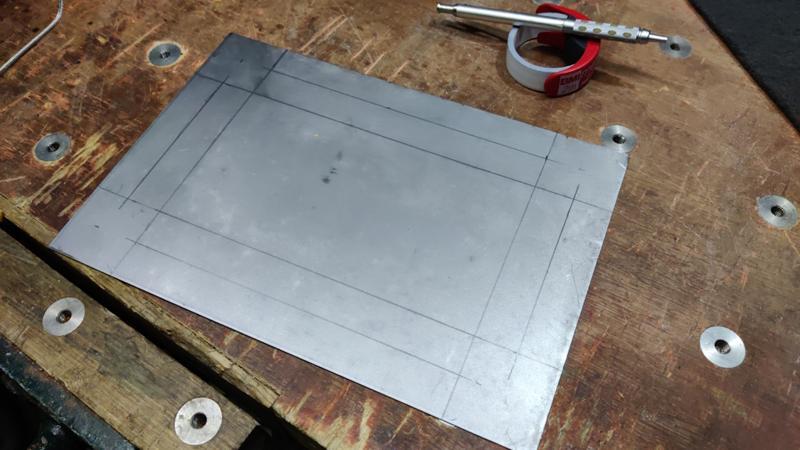
The pencil marks were positioned based on a combination of what size I wanted the end result to be and what size I the off-cut was. I started by marking out the rectangle that's about 44 mm from the edge and then decided 44 mm was a bit much, so I added a second line, 22 mm from each edge.
With the pencil marks in place, I took it over to the home-made vertical saw table on the bandsaw and cut out the corners:
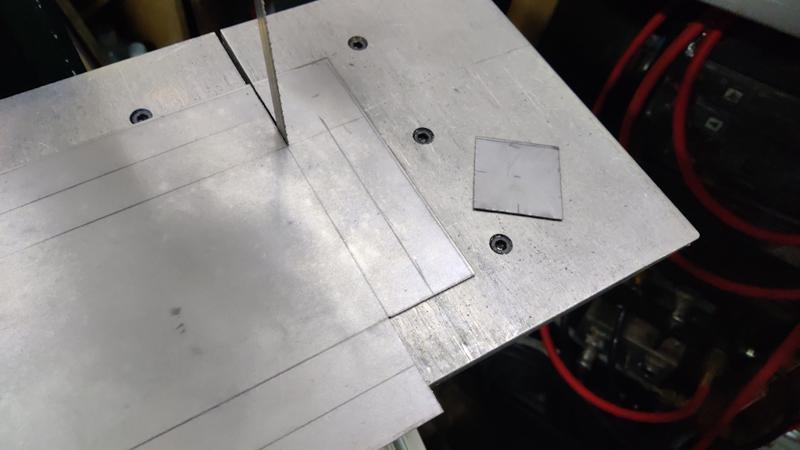
It was then time to get the sheet metal bender out. The first bend looked like this:
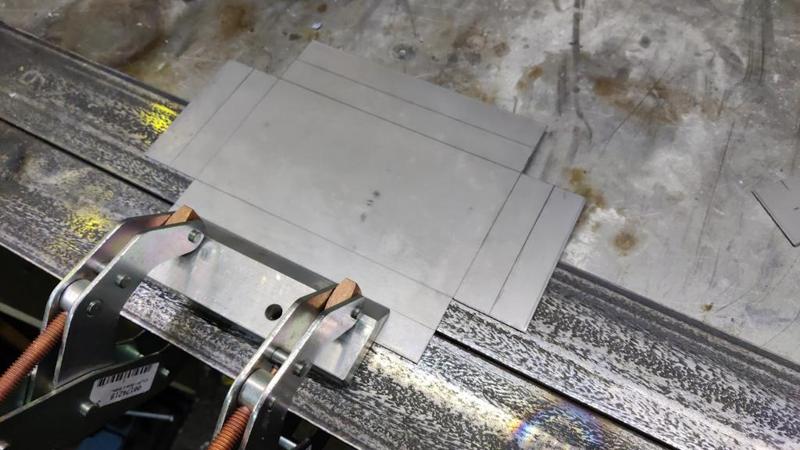
It probably would have been better to have a couple of clamping blocks so the ends were supported (which I did on the later bends) but it didn't seem to cause any problems. After the first bend:
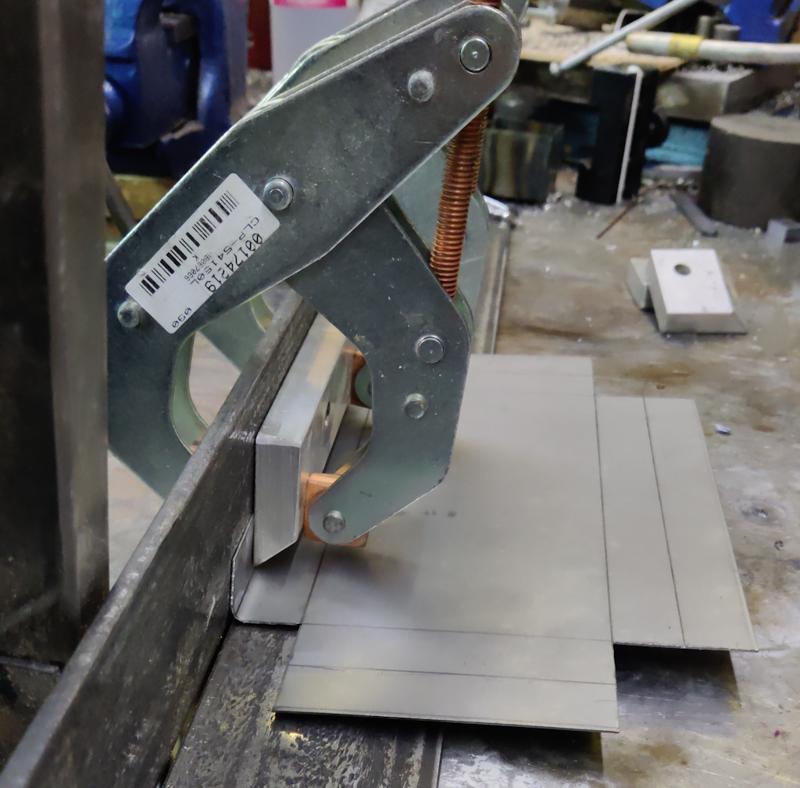
I then dug out a recently acquired and rather shabby hammer (I'll give it some TLC at some point: it needs a new handle and a thorough de-rust) and battered the folded over bit flat:
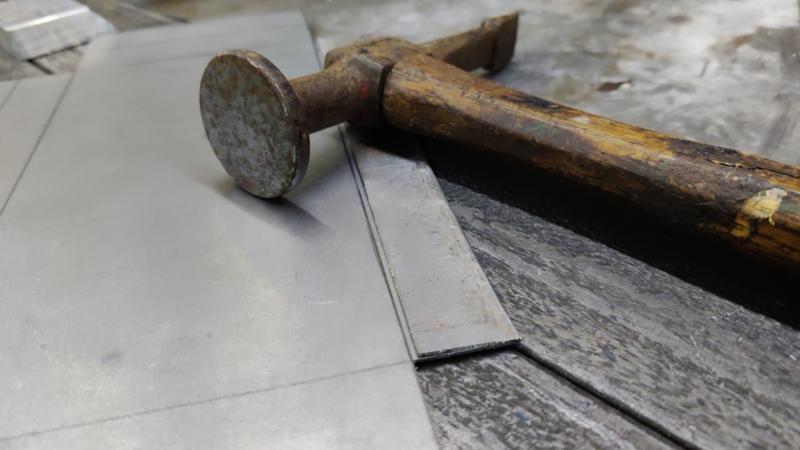
There was then a bit of rinse and repeat...
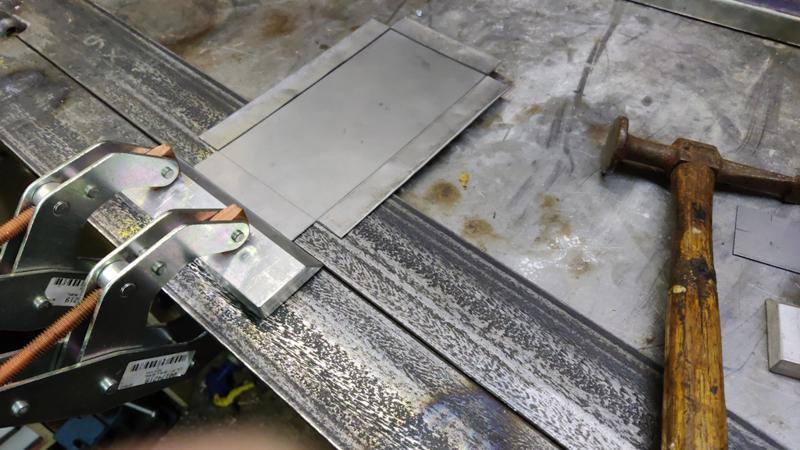
... and some more folding...
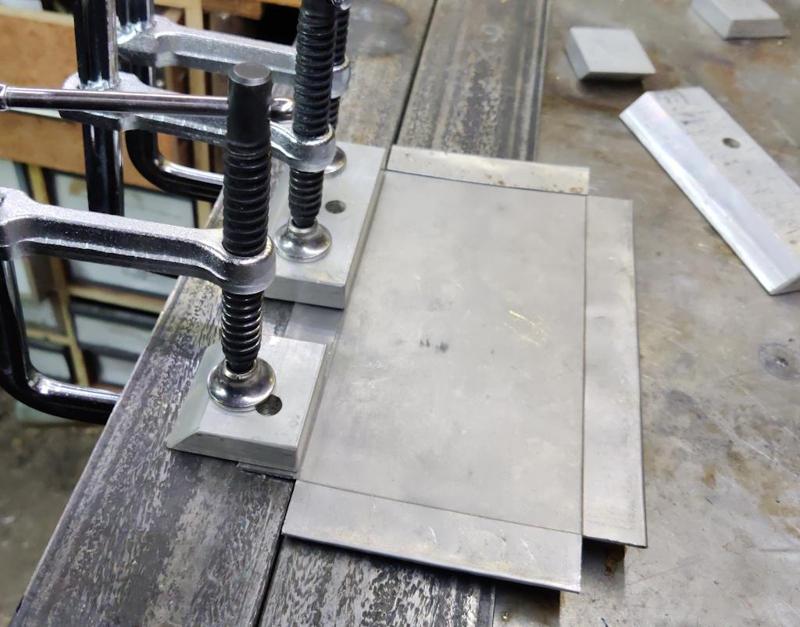
... and some more folding...
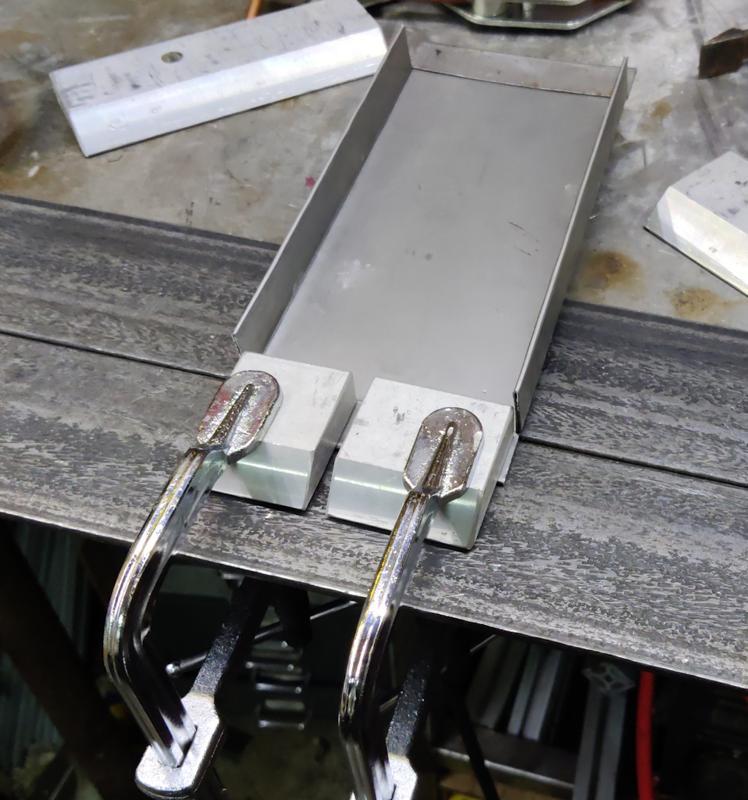
... and some more folding:
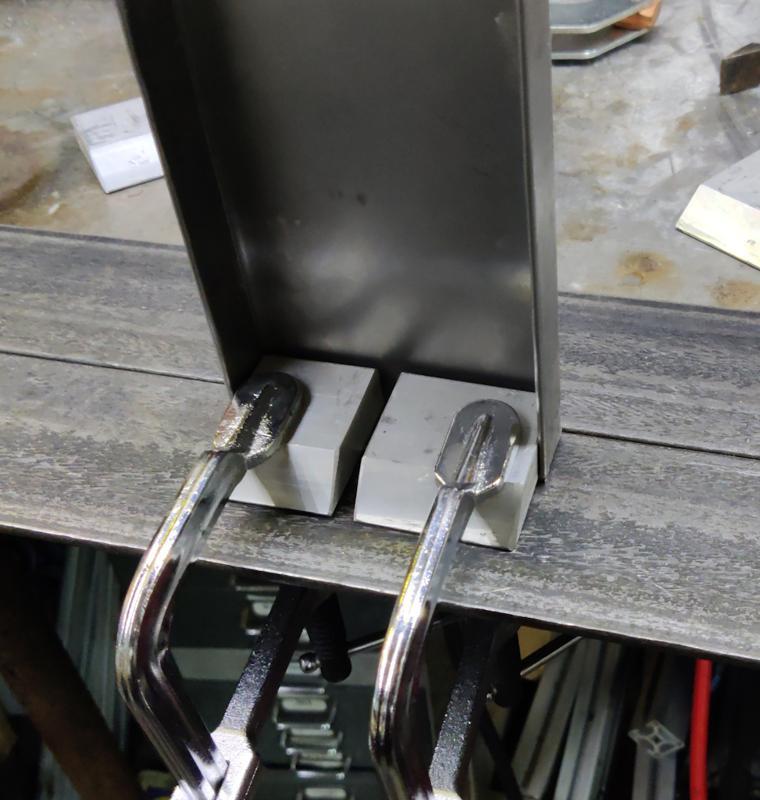
All that folding resulted in this little steel tray:
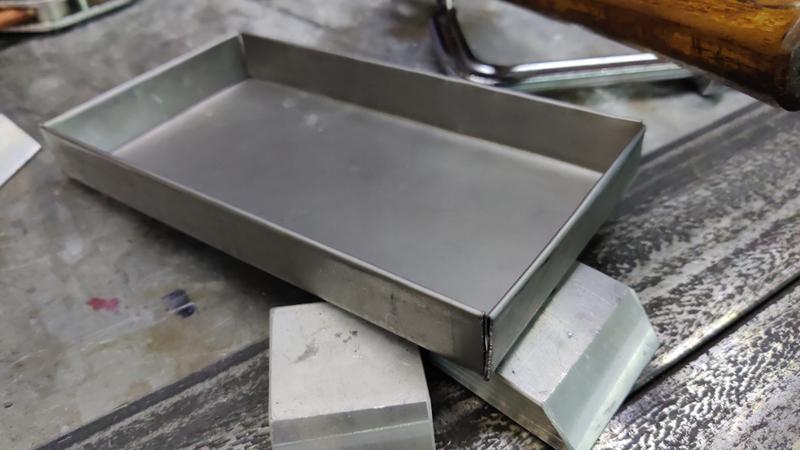
Making the corners watertight involved the (very) hot melt glue gun...
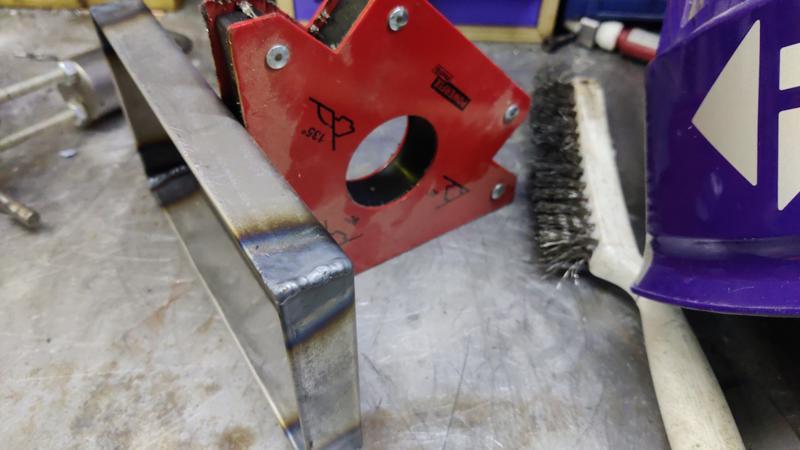
... followed by a flap disc in the angry grinder to remove the squeeze-out and complete the tray:
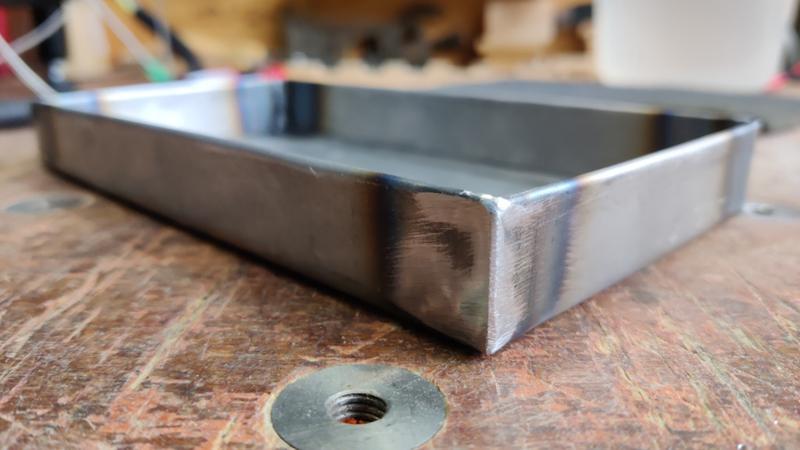
The plan for this tray is for it to sit in the heat treatment oven thus:
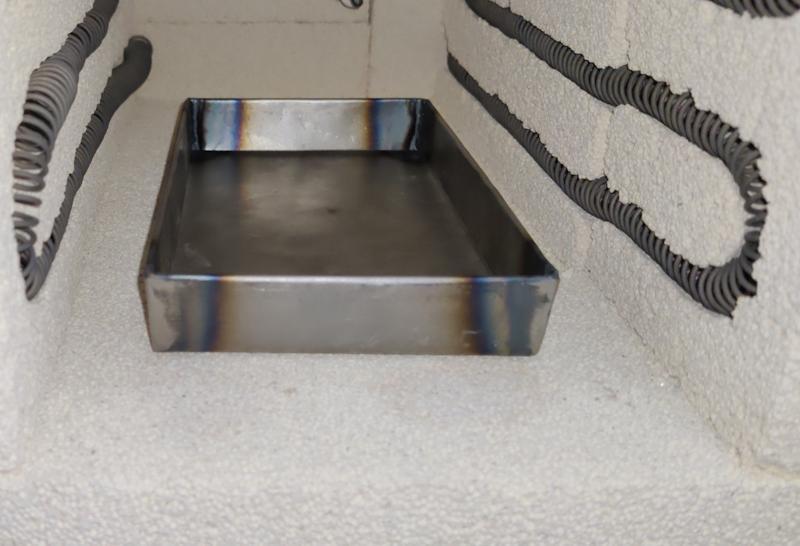
Often when heat treating, I've wrapped parts in iron wire and covered them in a mixture of boric acid and meths (the iron wire being there to stop the boric acid falling off). The boric acid stops oxidation/scale building up on the part and can be cleaned relatively easily by dunking the part in boiling water after the quench. However, the boric acid mix results in a bit of a mess underneath the part on whatever base I'm using for blow-torch based heat treatment.
For doing it in the oven I thought it would be better to have a tray. I can fill the tray with boric acid/meths and bury the part in the mixture. All being well, most of the mix will stay in the tray rather than ending up all over the bottom of the oven. It will, of course, make it a little harder to grab hold of the part for quenching, but I'll see how I get on. I suspect the tray will suffer somewhat from repeated cycles up to around 800°C, but it took me less than an hour to make and I've got lots more off-cuts, so I can always knock up a few spares if necessary.
While I've been typing this, I've also idly wondered if it might be viable to fill the tray (or perhaps one with higher side walls) with argon and put the part in that inert gas environment. Argon is heavier than air, so assuming there isn't too much of a breeze blowing in the chamber, I'd hope that it would stay put in the tray rather than dissipating. Of course, if any colder air got into the chamber (or the argon heated faster than the air), then that might not stay true (argon's density drops from about 1.6 kg/m³ to about 0.5 kg/m³ as the temperature goes from 20°C to 700°C; air density drops from about 1.2 kg/m³ to about 0.35 kg/m³ over the same temperature span). In practice, I wouldn't be surprised if there's always some fresh (cooler) air fighting its way into the chamber through little gaps here and there and if that air doesn't get up to temperature by the time it reaches the argon, then the argon will head for the roof, but it's an interesting possibility anyway.
If it worked, it would make for a much cheaper inert environment that having to knock up some sort of gas feed into the top of the chamber and maintaining a constant flow. I think the best way to test that idea will be to fill a tray with argon (but no parts), check there's no oxygen by dunking a lit match just below the lip, then heat it up to 800°C, let it cool and repeat the match test. I'd be interested to know if anyone has tried this.
Worst case, I'll stick with the boric acid, which seems to work okay when I've used it before.

The pencil marks were positioned based on a combination of what size I wanted the end result to be and what size I the off-cut was. I started by marking out the rectangle that's about 44 mm from the edge and then decided 44 mm was a bit much, so I added a second line, 22 mm from each edge.
With the pencil marks in place, I took it over to the home-made vertical saw table on the bandsaw and cut out the corners:

It was then time to get the sheet metal bender out. The first bend looked like this:

It probably would have been better to have a couple of clamping blocks so the ends were supported (which I did on the later bends) but it didn't seem to cause any problems. After the first bend:

I then dug out a recently acquired and rather shabby hammer (I'll give it some TLC at some point: it needs a new handle and a thorough de-rust) and battered the folded over bit flat:

There was then a bit of rinse and repeat...

... and some more folding...

... and some more folding...

... and some more folding:

All that folding resulted in this little steel tray:

Making the corners watertight involved the (very) hot melt glue gun...

... followed by a flap disc in the angry grinder to remove the squeeze-out and complete the tray:

The plan for this tray is for it to sit in the heat treatment oven thus:

Often when heat treating, I've wrapped parts in iron wire and covered them in a mixture of boric acid and meths (the iron wire being there to stop the boric acid falling off). The boric acid stops oxidation/scale building up on the part and can be cleaned relatively easily by dunking the part in boiling water after the quench. However, the boric acid mix results in a bit of a mess underneath the part on whatever base I'm using for blow-torch based heat treatment.
For doing it in the oven I thought it would be better to have a tray. I can fill the tray with boric acid/meths and bury the part in the mixture. All being well, most of the mix will stay in the tray rather than ending up all over the bottom of the oven. It will, of course, make it a little harder to grab hold of the part for quenching, but I'll see how I get on. I suspect the tray will suffer somewhat from repeated cycles up to around 800°C, but it took me less than an hour to make and I've got lots more off-cuts, so I can always knock up a few spares if necessary.
While I've been typing this, I've also idly wondered if it might be viable to fill the tray (or perhaps one with higher side walls) with argon and put the part in that inert gas environment. Argon is heavier than air, so assuming there isn't too much of a breeze blowing in the chamber, I'd hope that it would stay put in the tray rather than dissipating. Of course, if any colder air got into the chamber (or the argon heated faster than the air), then that might not stay true (argon's density drops from about 1.6 kg/m³ to about 0.5 kg/m³ as the temperature goes from 20°C to 700°C; air density drops from about 1.2 kg/m³ to about 0.35 kg/m³ over the same temperature span). In practice, I wouldn't be surprised if there's always some fresh (cooler) air fighting its way into the chamber through little gaps here and there and if that air doesn't get up to temperature by the time it reaches the argon, then the argon will head for the roof, but it's an interesting possibility anyway.
If it worked, it would make for a much cheaper inert environment that having to knock up some sort of gas feed into the top of the chamber and maintaining a constant flow. I think the best way to test that idea will be to fill a tray with argon (but no parts), check there's no oxygen by dunking a lit match just below the lip, then heat it up to 800°C, let it cool and repeat the match test. I'd be interested to know if anyone has tried this.
Worst case, I'll stick with the boric acid, which seems to work okay when I've used it before.
Dr.Al
Forum Supporter
- Messages
- 2,623
- Location
- Gloucestershire, UK
The next project I wanted to do with the oven was to make a wood turning tool. I started with a bit of 5 mm × 15 mm gauge plate, which I marked up with some Dykem:
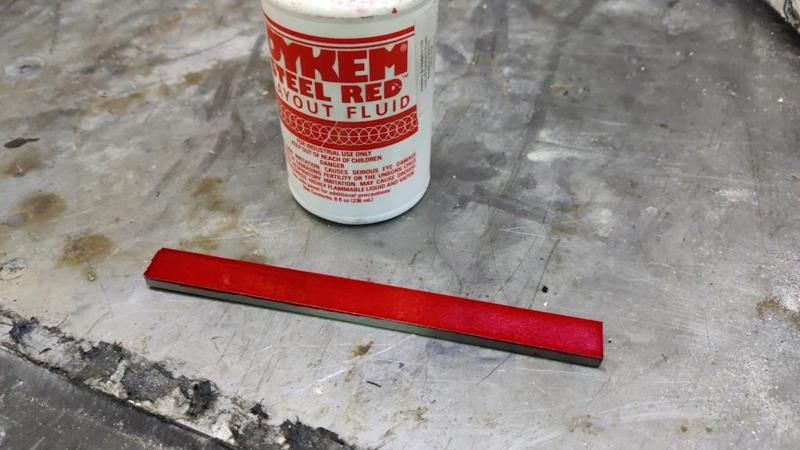
I'd made a dimensioned drawing based on a combination of inspecting a lathe tool in a shop and reading dimensions of some drawings of the things these tools are intended for. Based on that drawing, I scribed a few lines on the part as a guide. I then mounted the steel in the milling vice and attacked it with a 12 mm carbide end mill:
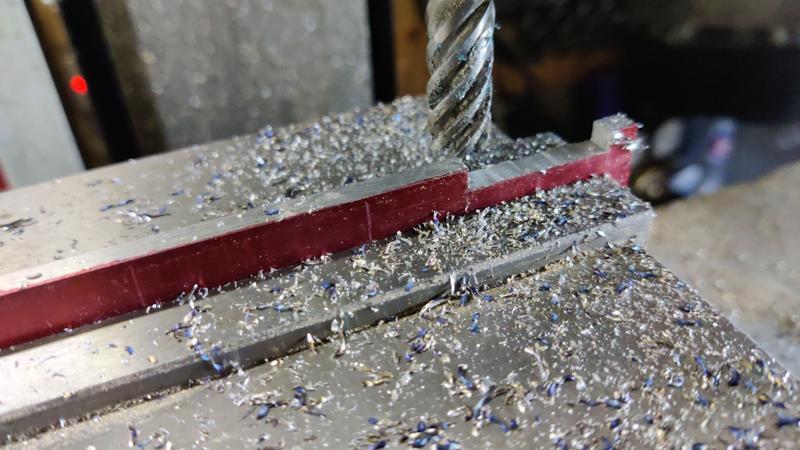
A few years ago, I made this tiny little d-bit engraving cutter for use with my home-made pantograph:
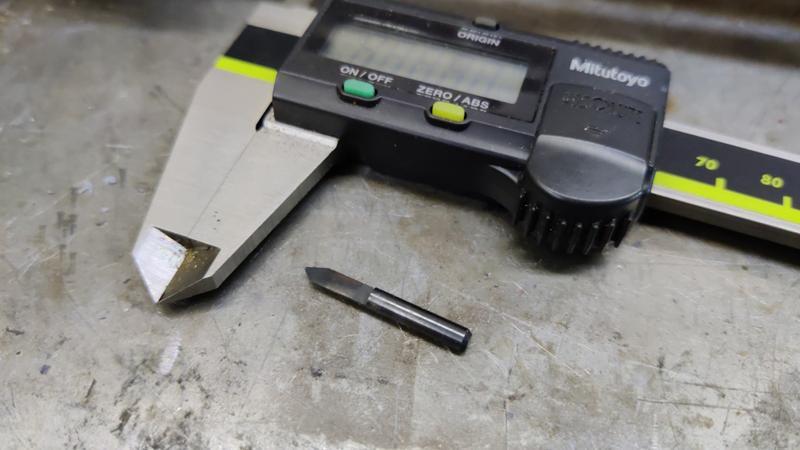
That was used to engrave a couple of lines in the top face of the steel bar:
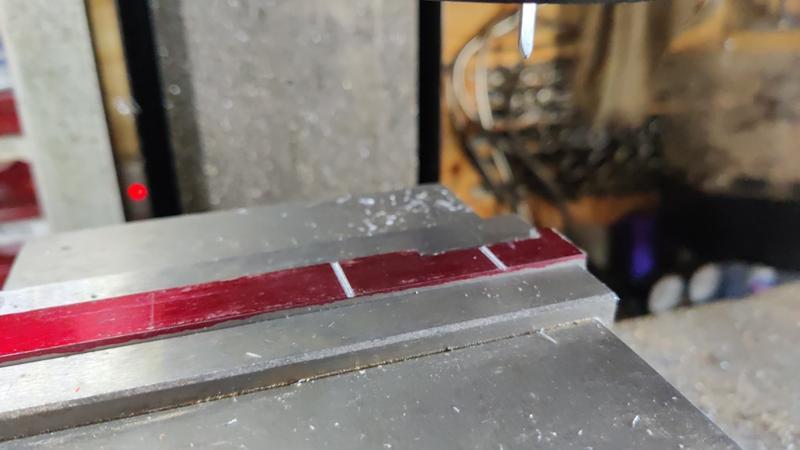
The part then got flipped around again to mill an angle on the back edge...
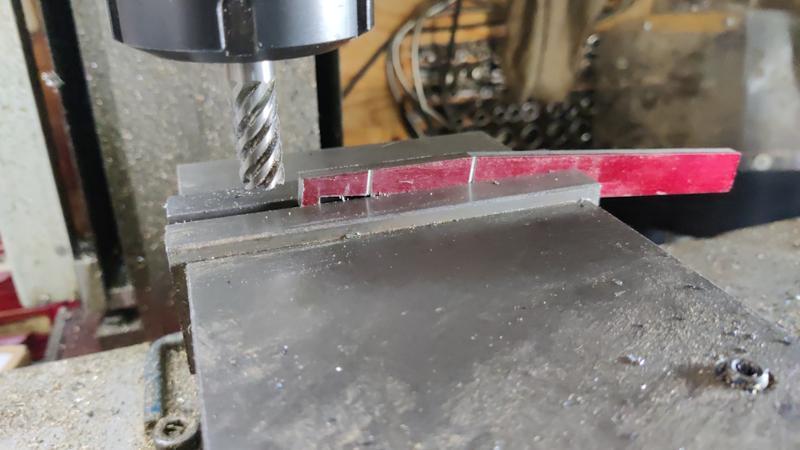
... and the last milling job was to make one end a bit narrower to form the tang. This wasn't an ideal way to support a part, but I wasn't aiming for anything especially precise (in all honesty, I suspect the whole part could have been made with hacksaws and files and been perfectly accurate):
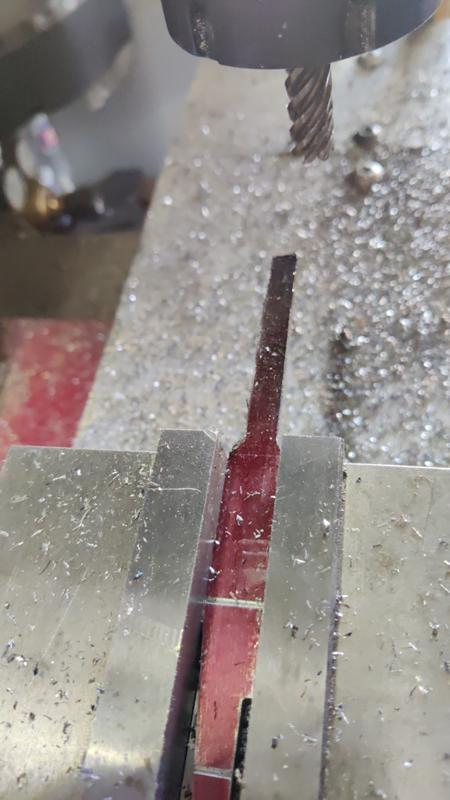
The tang then got filed a bit to give it a bit of a taper and to round over the edges slightly:
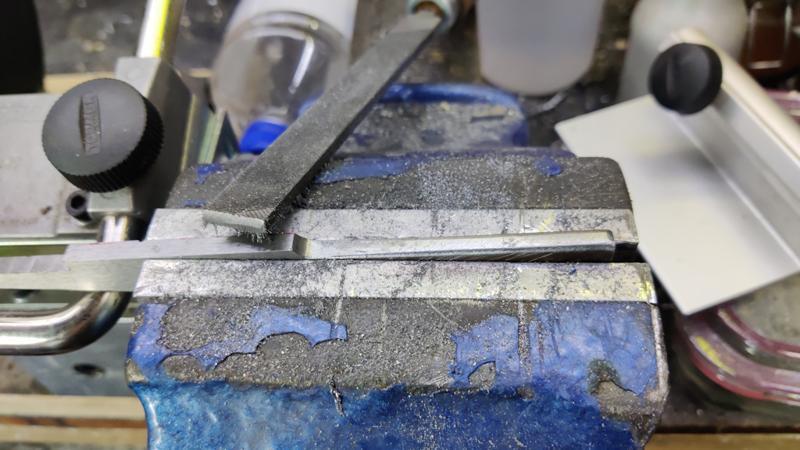
With all the shaping done, it was time for heat treating.
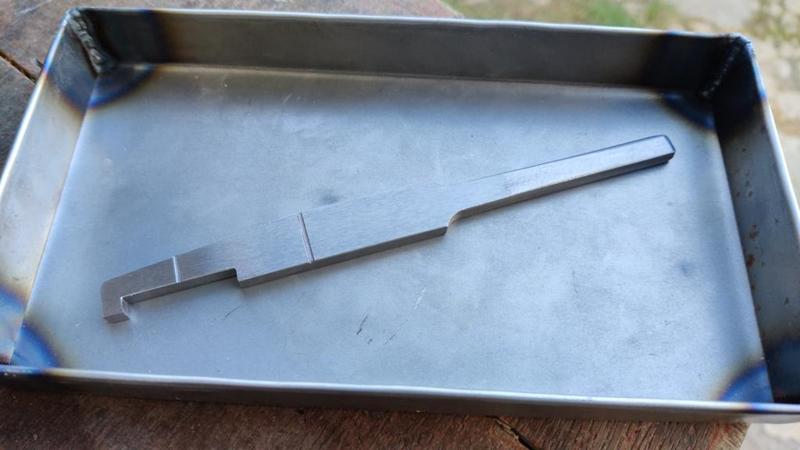
I put the tray in the oven and used the TIG torch (with lots of pre- and post-flow, a very low current setting and no tungsten installed) to "pour" some argon into the tray. After doing that for about a minute's worth of flow, I lit a match and lowered it slowly into the tray. It stayed lit, so that obviously didn't work at all!
I didn't want to spend too long (or waste too much gas) playing with it, so I went back to the boric acid plan: pouring some boric acid powder into the tray and then moistening it with meths:
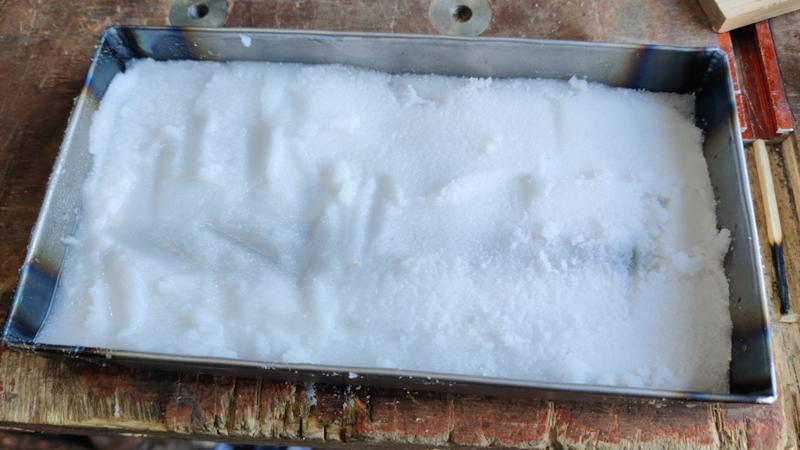
I then put the chamber on to heat up to 780°C. I initially had a go with the controller's programmer feature, but I'd obviously set something wrong with either the ramp rate or the hold-back level as it was constantly alternating between a short rise and then a hold-back, resulting in very little current flowing. I thought I'd set the hold-back threshold to be 20°C (i.e. it wouldn't try to slow the set point ramp until there was a 20°C difference between set point and chamber temperature), but it seemed to be kicking in at about 0.2°C. I decided to put off thinking about that for now and just used the standard single set point mode, which works fine for this application anyway.
As there was lots of meths in the enclosed space of the oven I was a little nervous of what might happen, so I set it running and then went and sat in the garden, just within sight of the chamber but with plenty of clear space in between (and a wall blocking most of the view). I needn't have worried though: the chamber isn't really that air tight: it's obviously air tight enough to allow it to get hot reasonably quickly and stay there, but there were little puffs of smoke coming out of the back of the chamber as the meths burnt off, so there's obviously enough in the way of a gap for it to be relatively safe. Nevertheless, I put a face mask on before opening the door, just in case.
When the part had come out of the oven and been quenched in vegetable oil, it had a glassy coating all over it from the boric acid:

That glassy coating is very easy to remove: you just put it in a container of some sort and pour boiling water over the top. That leaves it looking like this:
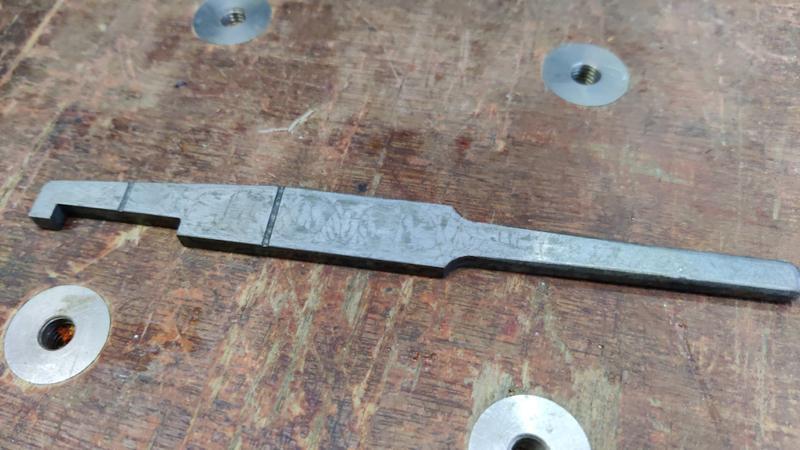
Somewhere between 30 seconds and a minute a side on 180 grit wet-and-dry paper leaves it looking like this:
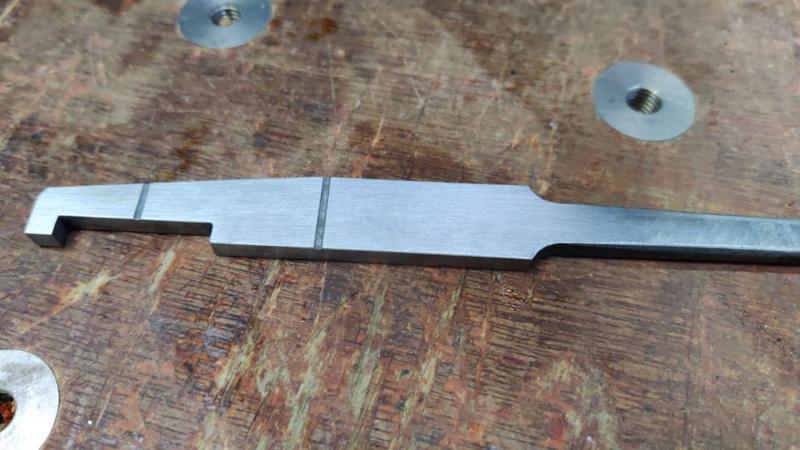
For this part, I decided to temper it with the blowtorch rather than the oven. There are a couple of reasons for that. The first is that I couldn't be bothered to wait for the oven to cool down. The second (and probably more important one) is that I wanted most of the part to be tempered to a higher temperature than the tip. Here's a very blurry photo of it being tempered in the flame of a blowtorch:
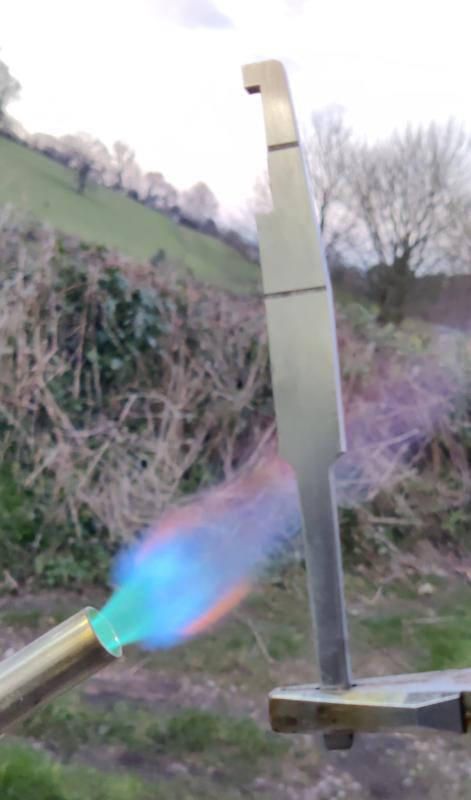
Yeah, not my best bit of photography that one. I hold it near the tang and heat it also near the tang, starting with a fairly strong flame to get it started and then turning the flame down as it gets closer to the target temperature. The rest is just done by looking at the colour: I was aiming for blue on most of the length and a straw-like colour at the very tip. That's done by moving the flame back and forth along the bit I wanted to get blue but staying well clear of the tip. As the paler colours move up the part towards the tip, I keep a careful eye on it and when the tip reaches the colour I'm after, I dunk it in vegetable oil to cool it back down again (and prevent the heat from the rest of the part overheating the tip).
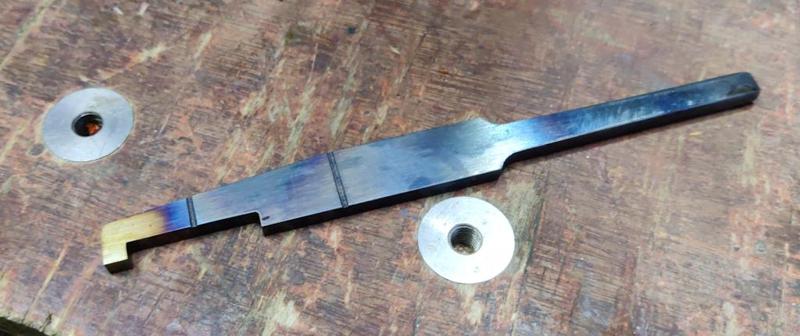
Once that was done, I gave it another quick rub-down on wet-and-dry paper and then ground some relief around the two sides adjacent to the top corner (bottom-left corner in the photo above). It was then time to make a handle, so after making a quick ferrule on the metal lathe, I got the home-made wood turning lathe out and a bit of Panga Panga from Yandles. That got roughed out with a roughing gouge:
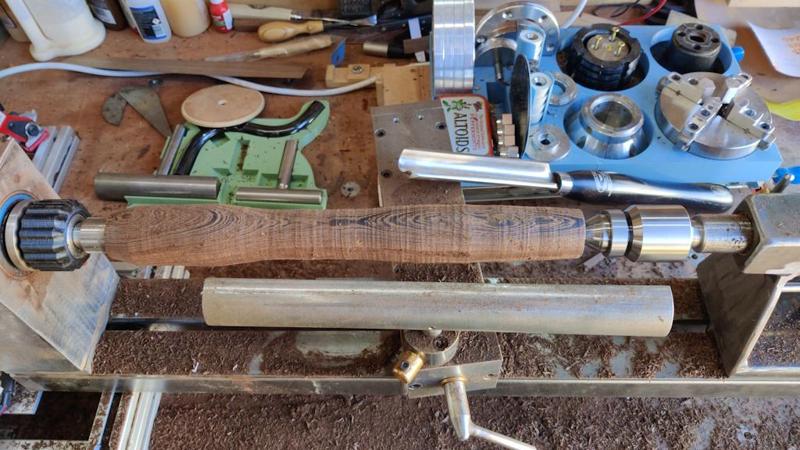
Then tidied up with a big wide skew chisel (a very good recommendation from my father: skew work is so much easier with a really wide skew chisel!)
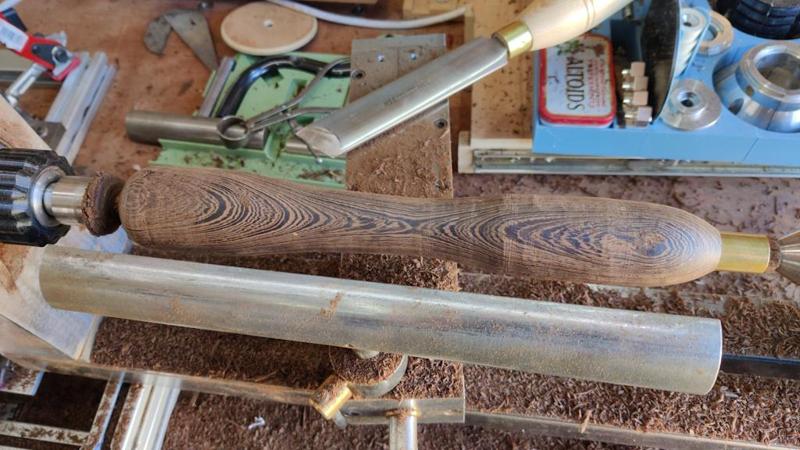
Finally, I finished it off with sand paper:
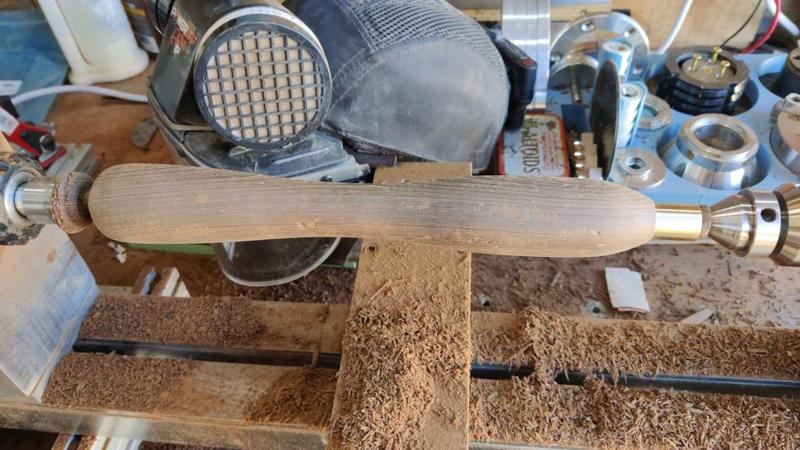
There are loads of blemishes on it (as a result of my lack-of-skill in wood turning), but for a tool that won't be used very often, I decided it wasn't worth having another go. A quick coat of Mike's Magic Mix and it was ready for a trial:
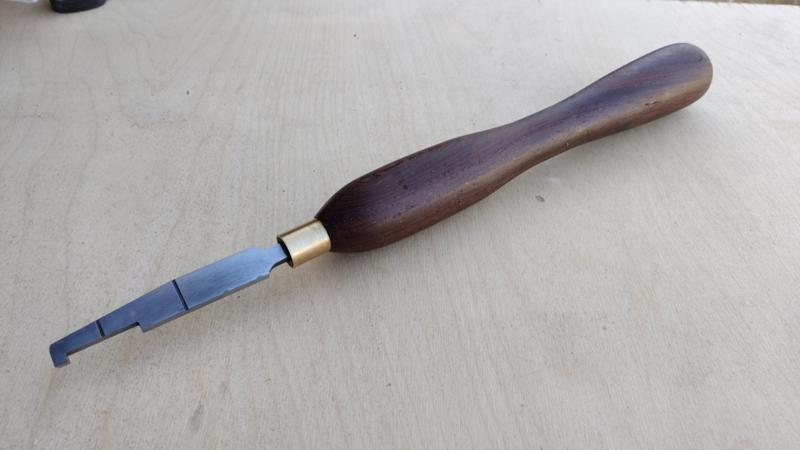
The tool is used for cutting some relief grooves for use with Crushgrind brand pepper mill mechanisms. I've got a Crushgrind pepper mill and have been really impressed with it and I thought it would be nice to make myself and a few friends/family some salt and pepper mill sets. The official tool is quite expensive for something that won't get used much, so I thought it would be much better to make my own.
In use, it gets shoved into the hole for the mechanism; one of the engraved lines is then lined up with the outside of the part and then it's pulled back to create a 5 mm wide groove at the correct depth. The two lines are there to show the position of two different grooves that are required for various Crushgrind mechanisms:
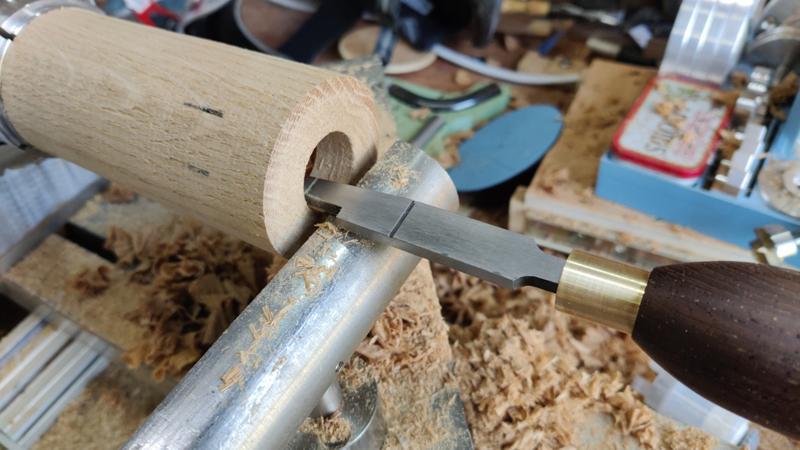
It works very well and created the groove quickly and easily. As for the rest of the turning of the pepper mill... well, let's just chalk that one down to practice: the firewood pile just got a little bigger.

I'd made a dimensioned drawing based on a combination of inspecting a lathe tool in a shop and reading dimensions of some drawings of the things these tools are intended for. Based on that drawing, I scribed a few lines on the part as a guide. I then mounted the steel in the milling vice and attacked it with a 12 mm carbide end mill:

A few years ago, I made this tiny little d-bit engraving cutter for use with my home-made pantograph:

That was used to engrave a couple of lines in the top face of the steel bar:

The part then got flipped around again to mill an angle on the back edge...

... and the last milling job was to make one end a bit narrower to form the tang. This wasn't an ideal way to support a part, but I wasn't aiming for anything especially precise (in all honesty, I suspect the whole part could have been made with hacksaws and files and been perfectly accurate):

The tang then got filed a bit to give it a bit of a taper and to round over the edges slightly:

With all the shaping done, it was time for heat treating.

I put the tray in the oven and used the TIG torch (with lots of pre- and post-flow, a very low current setting and no tungsten installed) to "pour" some argon into the tray. After doing that for about a minute's worth of flow, I lit a match and lowered it slowly into the tray. It stayed lit, so that obviously didn't work at all!
I didn't want to spend too long (or waste too much gas) playing with it, so I went back to the boric acid plan: pouring some boric acid powder into the tray and then moistening it with meths:

I then put the chamber on to heat up to 780°C. I initially had a go with the controller's programmer feature, but I'd obviously set something wrong with either the ramp rate or the hold-back level as it was constantly alternating between a short rise and then a hold-back, resulting in very little current flowing. I thought I'd set the hold-back threshold to be 20°C (i.e. it wouldn't try to slow the set point ramp until there was a 20°C difference between set point and chamber temperature), but it seemed to be kicking in at about 0.2°C. I decided to put off thinking about that for now and just used the standard single set point mode, which works fine for this application anyway.
As there was lots of meths in the enclosed space of the oven I was a little nervous of what might happen, so I set it running and then went and sat in the garden, just within sight of the chamber but with plenty of clear space in between (and a wall blocking most of the view). I needn't have worried though: the chamber isn't really that air tight: it's obviously air tight enough to allow it to get hot reasonably quickly and stay there, but there were little puffs of smoke coming out of the back of the chamber as the meths burnt off, so there's obviously enough in the way of a gap for it to be relatively safe. Nevertheless, I put a face mask on before opening the door, just in case.
When the part had come out of the oven and been quenched in vegetable oil, it had a glassy coating all over it from the boric acid:

That glassy coating is very easy to remove: you just put it in a container of some sort and pour boiling water over the top. That leaves it looking like this:

Somewhere between 30 seconds and a minute a side on 180 grit wet-and-dry paper leaves it looking like this:

For this part, I decided to temper it with the blowtorch rather than the oven. There are a couple of reasons for that. The first is that I couldn't be bothered to wait for the oven to cool down. The second (and probably more important one) is that I wanted most of the part to be tempered to a higher temperature than the tip. Here's a very blurry photo of it being tempered in the flame of a blowtorch:

Yeah, not my best bit of photography that one. I hold it near the tang and heat it also near the tang, starting with a fairly strong flame to get it started and then turning the flame down as it gets closer to the target temperature. The rest is just done by looking at the colour: I was aiming for blue on most of the length and a straw-like colour at the very tip. That's done by moving the flame back and forth along the bit I wanted to get blue but staying well clear of the tip. As the paler colours move up the part towards the tip, I keep a careful eye on it and when the tip reaches the colour I'm after, I dunk it in vegetable oil to cool it back down again (and prevent the heat from the rest of the part overheating the tip).

Once that was done, I gave it another quick rub-down on wet-and-dry paper and then ground some relief around the two sides adjacent to the top corner (bottom-left corner in the photo above). It was then time to make a handle, so after making a quick ferrule on the metal lathe, I got the home-made wood turning lathe out and a bit of Panga Panga from Yandles. That got roughed out with a roughing gouge:

Then tidied up with a big wide skew chisel (a very good recommendation from my father: skew work is so much easier with a really wide skew chisel!)

Finally, I finished it off with sand paper:

There are loads of blemishes on it (as a result of my lack-of-skill in wood turning), but for a tool that won't be used very often, I decided it wasn't worth having another go. A quick coat of Mike's Magic Mix and it was ready for a trial:

The tool is used for cutting some relief grooves for use with Crushgrind brand pepper mill mechanisms. I've got a Crushgrind pepper mill and have been really impressed with it and I thought it would be nice to make myself and a few friends/family some salt and pepper mill sets. The official tool is quite expensive for something that won't get used much, so I thought it would be much better to make my own.
In use, it gets shoved into the hole for the mechanism; one of the engraved lines is then lined up with the outside of the part and then it's pulled back to create a 5 mm wide groove at the correct depth. The two lines are there to show the position of two different grooves that are required for various Crushgrind mechanisms:

It works very well and created the groove quickly and easily. As for the rest of the turning of the pepper mill... well, let's just chalk that one down to practice: the firewood pile just got a little bigger.





